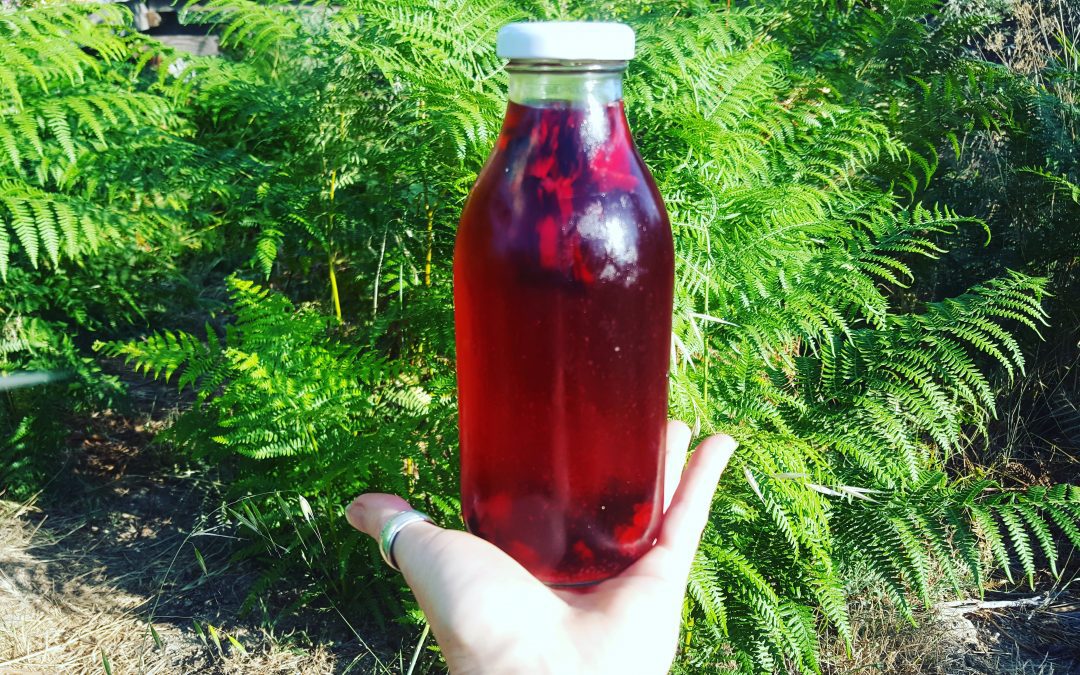So what is Kefir?
Kefir is a fermented/cultured probiotic drink. It comes in both ‘milk kefir’ and ‘water kefir’ forms.
As the name would suggest ‘milk kefir’ is made from milk, but not just dairy milk. Milk kefir is also made with coconut milk, almond milk, soya milk – pretty much anything that comes in milk form can be used to make milk kefir.
Water kefir is made from sugar water or coconut water.
Both can be flavoured with various fruits and vegetables (this usually happens on what they call a ‘second ferment’ of your product).
So why drink it?
1. Kefir is a much higher source of many different strains of healthy bacteria and yeasts. This is far higher in probiotic content than the yoghurts or little pots of probiotic drink you will find in a supermarket. Kefir is an excellent all round source of probiotics.
2. It is a wonderful detoxifying drink as it helps balance the yeasts and bacteria in the digestive system. This helps to eliminate bad yeasts and bacteria throughout the body.
3. Milk kefir is packed full of easily digestible calcium.
4. It’s full of amino acids and minerals essential for good health.
5. If you have a lactose intolerance you may find that you can tolerate using milk kefir products and in some cases the kefir even helps to heal the gut of this intolerance.
6. It is an excellent source of protein and can reduce cholesterol & high blood pressure.
7. It holds plenty of B vitamins, especially B12 and vitamin K.
8. It helps strengthen the immune system.
9. It can help with energy levels and cognitive function.
10. It’s thought to benefit autoimmune conditions.
11. It’s cheap and easy to make!
So how do you make it?
Milk kefir is slightly better for you than water kefir, but I prefer water kefir. Sometimes I make it with sugar water and sometimes with straight coconut water instead.
Directions:
1. Take a large mason jar and dissolve 1/4 cup of organic sugar into one cup of hot water into it. Then top up with another 3 cups  cold water (if the water is chlorinated then leave on the side for 24hrs before adding grains) . I then add 4 tbsp of water kefir grains.
cold water (if the water is chlorinated then leave on the side for 24hrs before adding grains) . I then add 4 tbsp of water kefir grains.
2. You can also add bicarbonate of soda, lemon, mineral drops or egg shell at this stage for added mineral content and healthy grains.
3. Secure some muslin or a coffee filter over the top of the mason jar with a rubber band.
4. Let it culture for 48 hours, a little less if you prefer it sweet and a little more if you prefer it slightly more sour (the more sour the less sugar is left in it).
5. When it reaches your preferred taste, separate the grains from the liquid through a plastic sieve (metal item can damage the grains). Then add grains directly into a new batch of sugar water.
6. You can now drink the liquid as it is, leaving it in the fridge in-between to slow down continued fermentation. 
7. You can now do a second ferment to add flavour to your kefir. Add juiced fruit or even vegetables like beetroot to the kefir drink and put in a closed mason jar or grolsch style bottle and close the lid firmly. This will allow the kefir to get fizzy like a flavoured soda. Leave this for another 24 to 72 hours and store in the fridge when it is at your preferred taste.
What I’ve learnt from my adventures:
1. If you’re not particularly healthy, have digestive issues, eat a lot of sugar or suspect that you have a yeast overgrowth then have only have a few sips of kefir each time to start with and slowly increase your intake. If you consume too much to start with, you may experience strong detox symptoms. These symptoms can be slightly unpleasant. This is particularly prevalent if you have an unhealthy digestive system.
2. Do not rinse grains in normal water if they need rinsing, use sugar water or coconut water.
3. Boil egg shells first otherwise they can cause mould.
4. Fruit is much better and stronger tasting if juiced rather than whole pieces of fruit added, but you can do this also, but it will need straining off.
5. Your grains should multiply slightly with each batch, if this is not happening then you may need to add more sugar or minerals.
6. Sweet fruits generally work better than sour fruits, especially strawberries, mmmm =)
7. Don’t use metal utensils (including sieves) with the grains as this can harm them.
8. If you buy dehydrated grains, they can take a few batches to get going properly. Have patience!
9. If you don’t want to make another batch straight away, then put the grains into super sugar water in the fridge (making sure to add more sugar after a week).
10. Eventually you’ll have too many grains. Why not give the extra ones to a friend, so that they can start their own. You can even eat the excess kefir grains!
It’s addictive! Once you start, you can’t stop!
It really can become addictive… but in a good way! =)
For more healthy hints, tips and recipes…
Get my newest book, Loving Yourself Inside & Out here.
My first book Living a Life Less Toxic here.
Or my second book, Cleanse – The Holistic Detox Program for Mind, Body and Soul here.




Thanks for this Faith. Where do you get the kefir grains from in the first place and what are they? Also, you said it’s good for yeast problems and yet there is so much sugar in it so I am confused (I am easily confused!). Can you explain a bit more please? Thanks
I purchased mine from ebay. Grains that haven’t been dehydrated do seem to be better/stronger.
It is great for yeast overgrowth issues as it is full of good yeasts and healthy bacteria, so helps to balance out the bad yeasts and bacteria in the body.
All the sugar in it is there to feed the good yeasts and bacteria, as long as you drink kefir slightly on the sour side it means all the sugar has been consumed.
I wouldn’t suggest this until after the six week die-off though.
Ok, thank you – I’ll wait for now.
Hi Faith,
Got my kefir grains this morning but the person sent a recipe that mentions solely using mineral water and adding baking soda or calcium carbonate. I think I’ll stick to your recipe and need to check with you the following. Do you deal the mason jar and cover with muslin or cover with cloth and not air tight close the lid? The note added to the grains mentioned a risk of explosion ?! Thanks Faith and have a nice day.
Fred
Hi Fred, Yes some people add all sorts to their ferments, but I like to keep it simple. If they don’t appear to be doing well then we can look at what you can add to perk them up, but other than that why complicate things? =0) Pop them in a mason jar and put muslin over the top. secured with an elastic band (do not put the lid on). You only need to add the lid if you decide to do a second ferment to make it fizzy and flavour it with a fruit, but I would work on mastering the first ferment first. Hope this helps
Hi Faith,
Thank you so much for your reply and help with this.
Me again … Sorry! Hmm not too sure it looks any different to day 1 (Monday). I have never tasted kefir before so am not sure how to know if something has happened or not. Should I try adding fruit or veg and see if fizz happens within next few days? Also, do you always remove the grains before adding fruit/ veg or after 24 hrs to help with second fermenting. I am a very excited newbie
Do you sell kefir grains and do you ship it. I am looikng for a starter. My daughter in law was telling me all about kefir but where do I get it thank you ,sincerely rita
Hi there,
No I don’t sell them, but you can purchase them from loads of different sellers on Ebay.
I would add to it that after the grains reovmed kefir should be refrigerated for at least 4 hours to stop the fermentation process and it is more enjoyable when chilled. Otherwise it might cause stomach upset. Correct me if I’m wrong.
Hi Sonia,
Yes whenever not drinking the kefir it should be stored in the fridge to stop further fermentation.